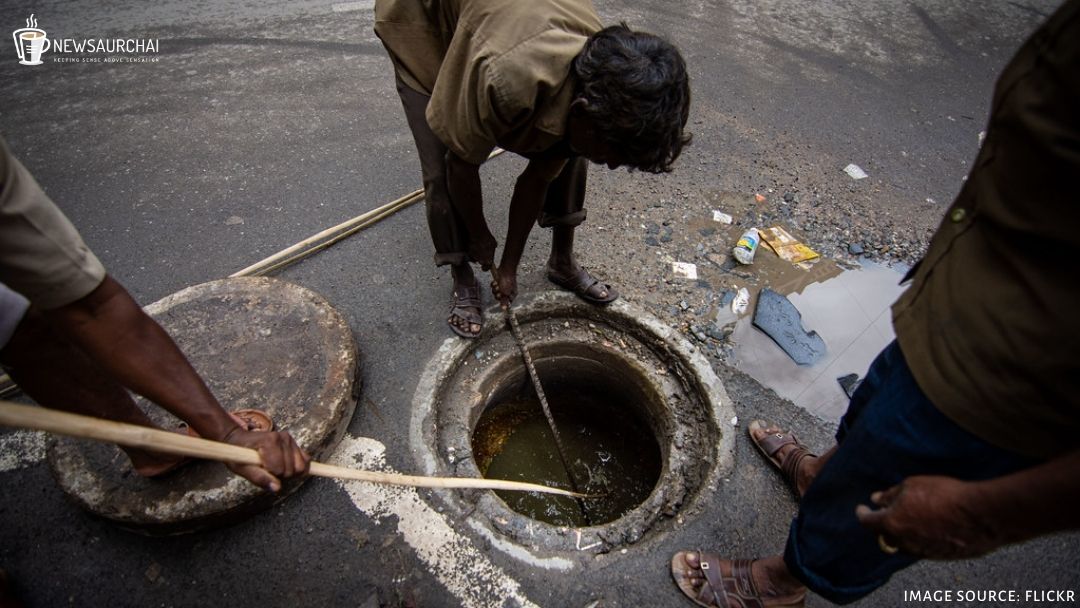
Seventy-three years after independence writing about the death of a sanitation worker / manual scavengers due to manual scavenging leaves me in dismay. It is appalling where at one end the country is engrossed in finding the untapped technological advances and on the other it witnesses death due to manual scavenging. The problem doesn’t end at the risk of life at job or deplorable working condition; the situation becomes all the more dangerous when you encounter its symphony with a particular caste.
Acts and its implementation
The practice of manual scavenging refers to manually cleaning, carrying, disposing of human excreta from toilets or sewers. Prohibition of Employment as Manual Scavengers and their Rehabilitation Act 2013 forbids the employment of any person asked to work as a manual scavenger.
According to the 2013 Act, no person, local authority or any agency shall “engage or employ, either directly or indirectly, any person for hazardous cleaning of a sewer or a septic tank.” It defined the term “hazardous cleaning” as carrying out such activities without the stipulated safety precautions. However, there are no convicts under the 2013 law for employing manual scavengers until at least July 2018.
Cases reported and actions taken:
The number of deaths has seen a rise despite a ban on manual scavenging. Around 620 cases have been reported since 1993, of which 88 took place in the past three years, according to the Social Justice and Empowerment Ministry.
Concerning the compensation granted to the victims, Social Justice and Empowerment Minister of State Ramdas Athawale told the Lok Sabha in 2019 that ‘compensation had been given in 445 cases, partial settlement in 58 cases, while 117 cases were pending.’
‘In 445 cases the full amount had been paid, while partial compensation had been given in 58 cases. Of the 15 States and Union Territories that submitted details to the Ministry, Tamil Nadu had the highest number of sewer deaths with 144 cases, followed by Gujarat with 131. Of the 88 cases reported in 2017, 2018 and 2019, till June 14, compensation was pending in 52 cases,’ reported The Hindu.
A national survey conducted in 18 States identifies a total of 48,345 manual scavengers till January 31, 2020. In Uttar Pradesh, 29,923 people were engaged in manual scavenging, making it the highest in any state in India, as per the data collected in 2018. In the last few years, the number of deaths while cleaning sewers and septic tanks has spiked, leading to the highest number of manual scavenging deaths in 2019, i.e., — 110 workers.
At least on papers, there are rigid provisions in the law on manual scavenging practice; however, it continues to be unabated in India. Besides, the abhorred practise is driven by caste, class and income divides, majorly caste. The caste aspect associated with it makes it a social problem as well. The practice can also be viewed as a prevalent manner harbouring untouchability in the country.
Movement against manual scavenging:
A movement was initiated in the 1990s to abolish the cruel practice, demanding introduction of mechanization for the removal and handling of waste in poisonous septic tanks. However, without a shadow of doubt, one can conclude that it has been left at an open juncture with no resolution whatsoever. The civil society, which once initiated the movement, is left to work out a solution at their conscious disposal.
The country which was unable to mechanize a way out to the problem has resorted to the hierarchical paradigm of social discrimination — the caste. The lowest in the chart — the Valmiki — end up entering the poisonous tanks unguarded leaving their lives to their fates.
Solution:
The introduction of mechanized systems for sewage cleaning needs human intervention for the process; however, the cleaning is done under Government often includes trained professionals with proper guards and equipment.
The problem lies when either untrained contractual workers do the hazardous work without proper guards or when people contact individuals of a particular caste with a presumption of the scavenging work done by them.
Hence, to resolve the issue, the states need to join hands with the Centre to undertake the sewage cleaning on regular intervals to stop people resorting to private labourers. Furthermore, identification and skill development of scavengers and rehabilitation are the areas the Governments should look upon. However, there is Government rehabilitation of one-time cash assistance of Rs. 40,000, loans up to Rs. 15,00,000 at concessional rate of interest and scholarship schemes for the children of manual scavengers but such one-time schemes are not enough for the workers to withdraw from practice completely.
There is a need for a collective consciousness and community-based model where each individual should feel a responsibility towards them and levy them with opportunities or guidance so that they can come out of this practice entirely.
The Government needs to implement policies to address the deplorable status of sanitation work and to manage the available resources judiciously to adopt alternative methods and assure a dignified and safe working environment for sanitation workers in the country. We, as a society, have intertwined the inhumane practice with caste hence, making it a legacy for a particular caste or class.
The constitution which promises a life of dignity to each of us should be held high, and the laws should be enforced strictly to eliminate manual scavenging in its totality.





